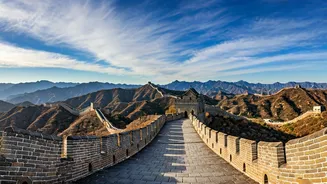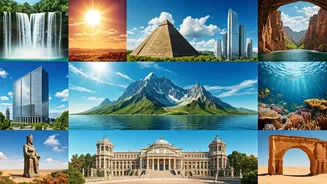Great Wall of China
Stretching thousands of miles across northern China, the Great Wall stands as a monumental feat of engineering. Construction began in the 7th century BC
and continued for centuries, involving millions of workers. Its primary purpose was defense, designed to protect the Chinese Empire from invaders. Walking along the wall, visitors are transported through time, witnessing the history of dynasties and conflicts. Sections vary in condition, from well-preserved areas to those in ruin, each tells a story of the past. The Great Wall showcases impressive architectural skills and a lasting symbol of China's rich cultural heritage. Visiting this landmark offers a profound appreciation for human perseverance and strategic brilliance.
The Colosseum, Rome
The Colosseum, an iconic symbol of ancient Rome, presents a powerful display of architectural prowess. Built in the 1st century AD, this massive amphitheater could hold up to 80,000 spectators. It hosted gladiatorial contests, public spectacles, and dramatic events that entertained the Roman populace. The Colosseum's design incorporated a complex system of arches, vaults, and corridors that provided both structural integrity and efficient crowd management. Despite the passage of centuries and damage from earthquakes and stone-robbing, the Colosseum's imposing presence still evokes the grandeur of the Roman Empire. Its presence provides insights into the social life, entertainment, and engineering capabilities of ancient Rome.
Machu Picchu, Peru
High in the Andes Mountains of Peru, Machu Picchu stands as a remarkable testament to the Inca civilization. Constructed in the 15th century, this ancient citadel reveals an intriguing blend of architecture and natural surroundings. Its precise stonework and terraced construction demonstrate Inca skill. Machu Picchu's remote location and sophisticated urban planning suggest a ceremonial or elite residential function. Hidden for centuries from the outside world, it was rediscovered in 1911 and soon captivated the global imagination. Today, the well-preserved ruins and stunning mountain views make Machu Picchu a prime destination for cultural exploration and historical immersion, embodying the spirit of the Inca civilization.
Petra, Jordan
Carved into sandstone cliffs, Petra in Jordan is a breathtaking ancient city. This UNESCO World Heritage site was established around the 6th century BC by the Nabataean civilization. Petra's most iconic structure, the Treasury, is a marvel of architecture. Its unique color comes from the different mineral composition of the sandstone. Petra's strategic location along trade routes facilitated its prosperity, making it a vital hub for merchants. The city's elaborate facades, water management systems, and intricate tombs provide insights into the Nabataean's skills. Visiting Petra offers a trip to a lost world, showcasing how ingenuity, commerce, and art could flourish in the desert.
Taj Mahal, India
The Taj Mahal, a mausoleum in Agra, India, is a symbol of eternal love and architectural elegance. Emperor Shah Jahan commissioned its construction in the 17th century to honor his wife, Mumtaz Mahal. Built from white marble, the Taj Mahal is adorned with intricate carvings, precious stones, and calligraphy, presenting a harmonious blend of Persian, Islamic, and Indian architectural styles. Its symmetrical design and serene beauty reflect a deep sense of peace. The Taj Mahal's exquisite craftsmanship, combined with its emotional history, makes it one of the most romantic destinations. The Taj Mahal continues to inspire awe and draw visitors from across the globe, ensuring its place as a lasting symbol of love.
Chichen Itza, Mexico
Chichen Itza, situated on Mexico's Yucatan Peninsula, offers a glimpse into the ancient Mayan civilization. It displays remarkable pyramids, temples, and observatories. The most notable structure, El Castillo, or the Temple of Kukulkan, reveals Mayan knowledge of mathematics and astronomy. Built between the 9th and 12th centuries AD, Chichen Itza showcases Mayan cosmology and religious practices. The site's well-preserved structures and carvings demonstrate Mayan architectural and artistic expertise. Visiting Chichen Itza is like traveling through history, offering insights into Mayan culture. The complex shows their advancements, from agriculture to astronomy, illustrating a sophisticated society.
Christ the Redeemer
Standing atop Corcovado Mountain in Rio de Janeiro, Brazil, Christ the Redeemer is a renowned statue. It was completed in 1931 and is an enduring symbol of Christianity and Brazilian culture. The statue's design combines art deco style with religious symbolism. It offers stunning panoramic views of Rio de Janeiro. The statue's open arms embrace the city, promoting a message of welcome and hope. The statue has become a global icon, representing peace and faith. The experience of seeing Christ the Redeemer combines spiritual significance with a breathtaking landscape. The statue welcomes millions each year.
Eiffel Tower, Paris
The Eiffel Tower, an iconic landmark in Paris, France, is a symbol of the city and engineering. Constructed in 1889 for the World's Fair, it became a controversial yet quickly cherished structure. Its innovative design, utilizing wrought iron lattice, was unprecedented. Standing at over 300 meters, it offers unparalleled views of Paris. Initially intended to be temporary, the tower's popularity led to its preservation and enduring status. The Eiffel Tower showcases how engineering and art can create a timeless masterpiece. The Eiffel Tower’s presence has transformed Paris's skyline, becoming a cultural symbol and attracting visitors from all over the world.
Colosseum, Rome
The Pyramids of Giza, located in Egypt, represent one of the world's most enduring and significant architectural achievements. Constructed over 4,500 years ago, these ancient structures served as tombs for the pharaohs and their consorts. The Great Pyramid of Giza, the largest of the three pyramids, is a testament to the advanced engineering and organizational skills of the ancient Egyptians. Its precise alignment with cardinal directions and internal chambers highlights their knowledge of mathematics and astronomy. The Pyramids of Giza are not only remarkable feats of construction but also offer insights into the religious beliefs and afterlife practices of ancient Egypt, making them a must-see for anyone interested in history and archaeology.














